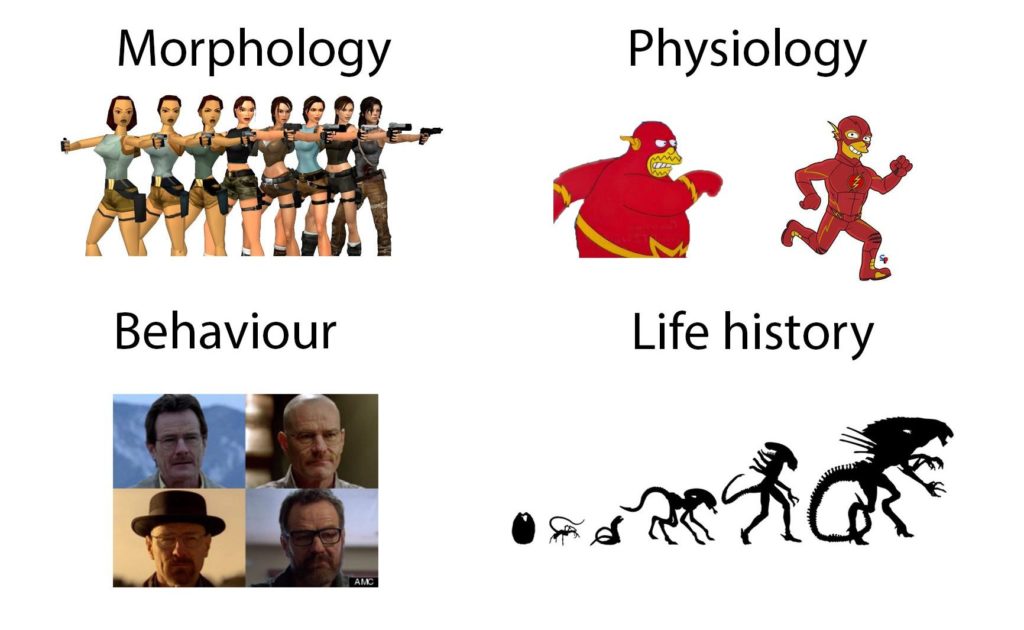
Screenshot of Jeff Goldblum's character saying "Life, uh, finds a way."
“Life, uh, finds a way,” Dr. Ian Malcolm (Jeff Goldblum)
Jeff Goldblum may have only been pretending to be a scientist (and talking about fictional dinosaurs), but he kind of hit the nail on the head with that famous quote. The more we learn, the more we’re in awe of the solutions animals and plants find for the many challenges that come with living on this big blue planet.
This is particularly important in an era of rapid environmental changes induced by human activities. How will organisms respond to projected future environmental conditions? What are their solutions to cope with major threats such as climate change? In principle, we know they can respond in at least three ways: organisms can take flight (through migration), fight (adjusting their biology through acclimatisation and/or adaptation) or they can die. All of these potential responses are conditioned by, perhaps, one of the most important characteristics of nature, the existence of variation.
We can see variation in the biological features of organisms, called ‘phenotypes’ or ‘traits’, and we can feel variation in the physical factors of their environments. The coupling between these two components of nature — phenotype and environment — has driven the evolution and diversification of life on earth during the last 3.5 billion years.
This continuous dance between environmental variation and biological variation is shaped by the music of natural selection. Some individuals with certain heritable characteristics that make them better fitted (adapted) to an environment tend to survive and reproduce more than others.

Admit it – you only pretend to know the difference between wines. Photo: Carl Davies
As you can imagine, organisms consist of many traits/phenotypes (e.g. size, weight, shape, colour, behaviour) that are interconnected. These phenotypes are the result of the instructions that are ‘hardwired’ in the organism’s genes, which is why organisms of the same species are so similar. But every individual within a species can be slightly different (even clones and twins!!). These differences are in part due to differences in the instructions but they are also due to differences in the particular environment of the organisms.
For example, if you taste a Cabernet Sauvignon from France and then compare this wine with the same variety from California, Chile or Australia, you will find that they smell and taste different! Same genes but different environments, this exquisite combination creates phenotypic variation in nature.
Phenotypic variation can also be found within the same organism. Organisms can show different values of a phenotype in different moments of their life — consider your weight before and after holidays, for example. This is thanks to phenotypic plasticity: an amazing tool that enables organisms to change their phenotypes (traits) without changing their instructions (their genes). Phenotypic plasticity can be found in almost any organismal trait from morphology to physiology, phenology-development, even to behaviour. Because a picture says a thousand words, we figured they’d be able to explain this concept better than our words ever could.

Phenotypic plasticity can be found in almost any organismal trait.
This plasticity allows organisms and populations to cope with environmental changes such as fluctuating temperatures during seasons. However, if environmental changes push beyond the plastic capacity of the organisms (there are limits conditioned by physics), then organisms need to adapt to the new conditions or fail. This is where natural selection comes in: it acts on the phenotypes (what you see) not on the genotypes (the genetic configuration that is hidden within the organisms), and its consequences occur in populations. Organisms do not evolve, populations do.
Threatened species, or threatened populations?
So, you say, why are you teaching me about this? Because we often discuss threatened species as a single unit, but perhaps we should be focussing on threatened ‘populations’ instead.
We’ve explored the effects of ocean warming and acidification on the adaptive capacity of marine life (algae, sea urchins and crabs) from different geographic regions and one common characteristic is that most populations of marine organisms exhibit some degree of plasticity and some potential for adaptation. However, there are differences among populations in these characteristics.
Populations in harsher and more variable environments show higher plasticity than those from more stable environments.
This higher plasticity allows them to cope with the stronger environmental variation they experience during the year, and has resulted from natural selection acting in the past. However there is a cost here for these more plastic populations. While favouring more resistant and tolerant organisms, natural selection has also reduced the genetic diversity of populations in these harsher environments. This lower genetic variation may constrain the potential for these populations to adapt to the conditions expected under a changing climate.
Our results have shown that the action of natural selection can change across the geographic range and distribution of a species. These geographic gradients in selection can drive phenotypic and genetic differences among populations that can help us understand how adaptive evolution functions under climate change.
We can also apply this knowledge to help protect threatened populations. Continuing with the analogy from the image above, if we find a population in one area with low genetic diversity and with only ‘fat Flashes’ that are too slow to outrun an introduced ‘predator’ (natural selection), then we can bring in some ‘fitter and faster Flashes’ from other populations with higher genetic diversity in order to enhance diversity and improve the potential for adaptive change.


Interested in our environmental research?